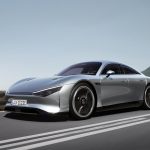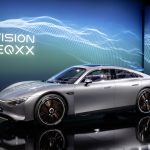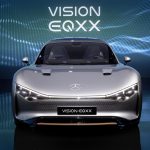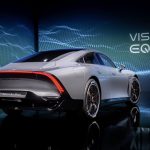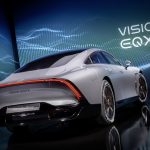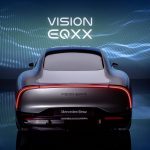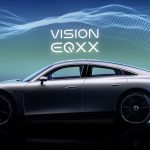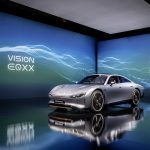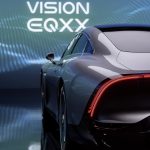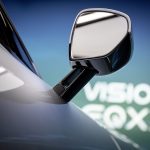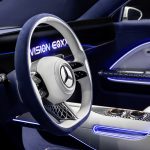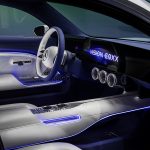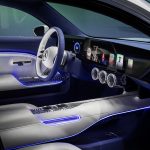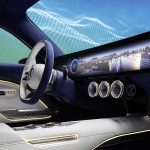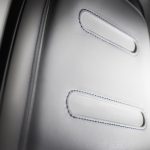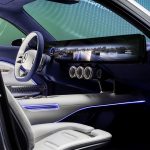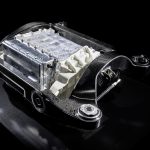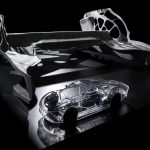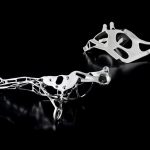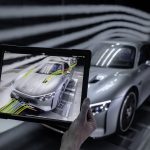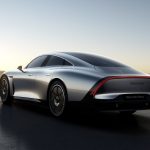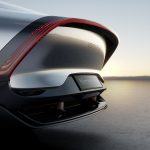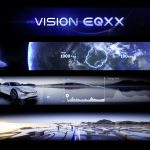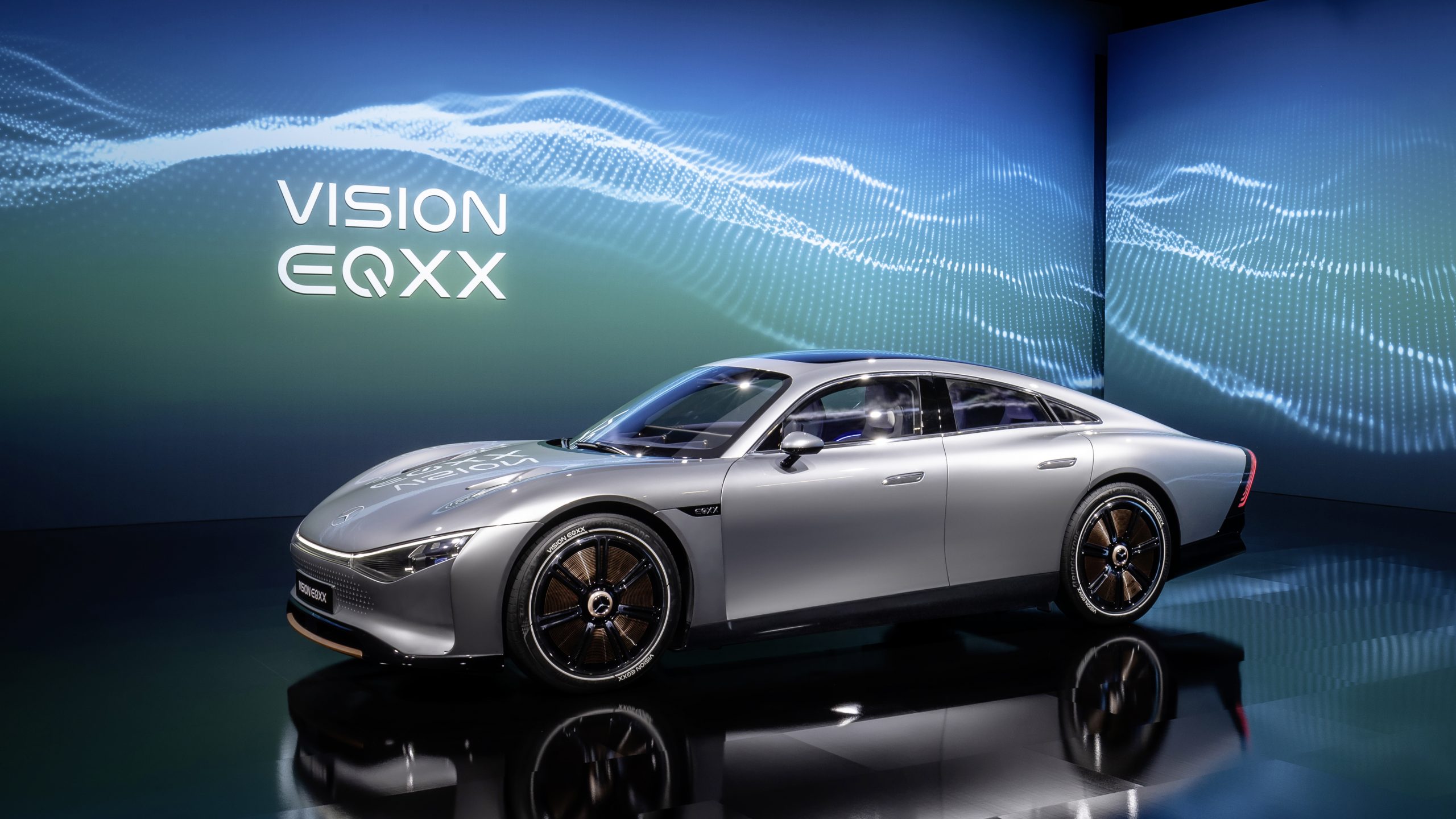
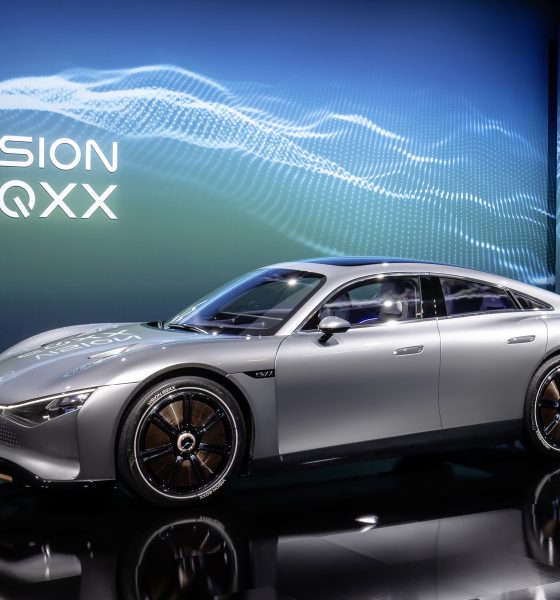
News
Mercedes-Benz VISION EQXX has considerably more range than any EV offered currently
German automaker Mercedes-Benz unveiled an electric car with 620 miles, or 1,000 kilometers, of range on Monday. The VISION EQXX has the potential to revolutionize electric vehicle road trips and overall adoption, offering considerably more range than any other EV on the market.
While the current projections for range are extending far past any electrified model currently offered by any company on the market, the figures were obtained by using internal digital simulations or real-life traffic conditions.
“The technology program behind the VISION EQXX will define and enable future Mercedes-Benz models and features,” Markus Schäfer, Member of the Board of Management of Daimler AG and Mercedes-Benz AG, Chief Technology Officer responsible for Development and Procurement, said. “As a halo car, the VISION EQXX firmly establishes Mercedes-Benz as the brand that pairs luxury with technology in the automotive world and beyond. And the way we developed it is as revolutionary as the vehicle itself. VISION EQXX has seen the best minds from our R&D centers work together with engineers from our Formula 1 and Formula E programs. They are proving that innovations from motorsport – where powertrains are already highly electrified – have immediate relevance for road car development. We are challenging current development processes with innovative spirit and outside-the-box thinking. This truly is the way forward.”
There is a lot to unpack in Mercedes’ lengthy press release, which features all of the fine points of the vehicle. However, the vehicle has lofty and somewhat groundbreaking expectations, even for a company that has as much story and tradition as Mercedes-Benz does. Executives have no issues looking at it as something that will undoubtedly be on the roads in the future. “All the elements that we see in this car will make it into series production,” Schäfer added.
- Der VISION EQXX zeigt, wie sich Mercedes-Benz die Zukunft des Elektroautos vorstellt. Das Auto hat eine Reichweite von mehr als 1.000 Kilometern und einen Energieverbrauch von weniger als 10 kWh pro 100 Kilometer. Der VISION EQXX steht für neue Maßstäbe hinsichtlich Energieeffizienz und Reichweite im realen Straßenverkehr sowie für die revolutionäre Entwicklung von Elektroautos. // The VISION EQXX is how Mercedes-Benz imagines the future of electric cars. The car has a range of more than 1,000 kilometres with an outstanding energy consumption of less than 10 kWh per 100 kilometres. The VISION EQXX stands for major new advances: it sets new standards in terms of energy efficiency and range in real-life traffic, and revolutionises the development of electric cars.
- Der VISION EQXX zeigt, wie sich Mercedes-Benz die Zukunft des Elektroautos vorstellt. Das Auto hat eine Reichweite von mehr als 1.000 Kilometern und einen Energieverbrauch von weniger als 10 kWh pro 100 Kilometer. Der VISION EQXX steht für neue Maßstäbe hinsichtlich Energieeffizienz und Reichweite im realen Straßenverkehr sowie für die revolutionäre Entwicklung von Elektroautos. // The VISION EQXX is how Mercedes-Benz imagines the future of electric cars. The car has a range of more than 1,000 kilometres with an outstanding energy consumption of less than 10 kWh per 100 kilometres. The VISION EQXX stands for major new advances: it sets new standards in terms of energy efficiency and range in real-life traffic, and revolutionises the development of electric cars.
- Der VISION EQXX zeigt, wie sich Mercedes-Benz die Zukunft des Elektroautos vorstellt. Das Auto hat eine Reichweite von mehr als 1.000 Kilometern und einen Energieverbrauch von weniger als 10 kWh pro 100 Kilometer. Der VISION EQXX steht für neue Maßstäbe hinsichtlich Energieeffizienz und Reichweite im realen Straßenverkehr sowie für die revolutionäre Entwicklung von Elektroautos. // The VISION EQXX is how Mercedes-Benz imagines the future of electric cars. The car has a range of more than 1,000 kilometres with an outstanding energy consumption of less than 10 kWh per 100 kilometres. The VISION EQXX stands for major new advances: it sets new standards in terms of energy efficiency and range in real-life traffic, and revolutionises the development of electric cars.
- Der VISION EQXX zeigt, wie sich Mercedes-Benz die Zukunft des Elektroautos vorstellt. Das Auto hat eine Reichweite von mehr als 1.000 Kilometern und einen Energieverbrauch von weniger als 10 kWh pro 100 Kilometer. Der VISION EQXX steht für neue Maßstäbe hinsichtlich Energieeffizienz und Reichweite im realen Straßenverkehr sowie für die revolutionäre Entwicklung von Elektroautos. // The VISION EQXX is how Mercedes-Benz imagines the future of electric cars. The car has a range of more than 1,000 kilometres with an outstanding energy consumption of less than 10 kWh per 100 kilometres. The VISION EQXX stands for major new advances: it sets new standards in terms of energy efficiency and range in real-life traffic, and revolutionises the development of electric cars.
- Der VISION EQXX zeigt, wie sich Mercedes-Benz die Zukunft des Elektroautos vorstellt. Das Auto hat eine Reichweite von mehr als 1.000 Kilometern und einen Energieverbrauch von weniger als 10 kWh pro 100 Kilometer. Der VISION EQXX steht für neue Maßstäbe hinsichtlich Energieeffizienz und Reichweite im realen Straßenverkehr sowie für die revolutionäre Entwicklung von Elektroautos. // The VISION EQXX is how Mercedes-Benz imagines the future of electric cars. The car has a range of more than 1,000 kilometres with an outstanding energy consumption of less than 10 kWh per 100 kilometres. The VISION EQXX stands for major new advances: it sets new standards in terms of energy efficiency and range in real-life traffic, and revolutionises the development of electric cars.
- Der VISION EQXX zeigt, wie sich Mercedes-Benz die Zukunft des Elektroautos vorstellt. Das Auto hat eine Reichweite von mehr als 1.000 Kilometern und einen Energieverbrauch von weniger als 10 kWh pro 100 Kilometer. Der VISION EQXX steht für neue Maßstäbe hinsichtlich Energieeffizienz und Reichweite im realen Straßenverkehr sowie für die revolutionäre Entwicklung von Elektroautos. // The VISION EQXX is how Mercedes-Benz imagines the future of electric cars. The car has a range of more than 1,000 kilometres with an outstanding energy consumption of less than 10 kWh per 100 kilometres. The VISION EQXX stands for major new advances: it sets new standards in terms of energy efficiency and range in real-life traffic, and revolutionises the development of electric cars.
- Der VISION EQXX zeigt, wie sich Mercedes-Benz die Zukunft des Elektroautos vorstellt. Das Auto hat eine Reichweite von mehr als 1.000 Kilometern und einen Energieverbrauch von weniger als 10 kWh pro 100 Kilometer. Der VISION EQXX steht für neue Maßstäbe hinsichtlich Energieeffizienz und Reichweite im realen Straßenverkehr sowie für die revolutionäre Entwicklung von Elektroautos. // The VISION EQXX is how Mercedes-Benz imagines the future of electric cars. The car has a range of more than 1,000 kilometres with an outstanding energy consumption of less than 10 kWh per 100 kilometres. The VISION EQXX stands for major new advances: it sets new standards in terms of energy efficiency and range in real-life traffic, and revolutionises the development of electric cars.
- Der VISION EQXX zeigt, wie sich Mercedes-Benz die Zukunft des Elektroautos vorstellt. Das Auto hat eine Reichweite von mehr als 1.000 Kilometern und einen Energieverbrauch von weniger als 10 kWh pro 100 Kilometer. Der VISION EQXX steht für neue Maßstäbe hinsichtlich Energieeffizienz und Reichweite im realen Straßenverkehr sowie für die revolutionäre Entwicklung von Elektroautos. // The VISION EQXX is how Mercedes-Benz imagines the future of electric cars. The car has a range of more than 1,000 kilometres with an outstanding energy consumption of less than 10 kWh per 100 kilometres. The VISION EQXX stands for major new advances: it sets new standards in terms of energy efficiency and range in real-life traffic, and revolutionises the development of electric cars.
- Der VISION EQXX zeigt, wie sich Mercedes-Benz die Zukunft des Elektroautos vorstellt. Das Auto hat eine Reichweite von mehr als 1.000 Kilometern und einen Energieverbrauch von weniger als 10 kWh pro 100 Kilometer. Der VISION EQXX steht für neue Maßstäbe hinsichtlich Energieeffizienz und Reichweite im realen Straßenverkehr sowie für die revolutionäre Entwicklung von Elektroautos. // The VISION EQXX is how Mercedes-Benz imagines the future of electric cars. The car has a range of more than 1,000 kilometres with an outstanding energy consumption of less than 10 kWh per 100 kilometres. The VISION EQXX stands for major new advances: it sets new standards in terms of energy efficiency and range in real-life traffic, and revolutionises the development of electric cars.
- Der VISION EQXX zeigt, wie sich Mercedes-Benz die Zukunft des Elektroautos vorstellt. Das Auto hat eine Reichweite von mehr als 1.000 Kilometern und einen Energieverbrauch von weniger als 10 kWh pro 100 Kilometer. Der VISION EQXX steht für neue Maßstäbe hinsichtlich Energieeffizienz und Reichweite im realen Straßenverkehr sowie für die revolutionäre Entwicklung von Elektroautos. // The VISION EQXX is how Mercedes-Benz imagines the future of electric cars. The car has a range of more than 1,000 kilometres with an outstanding energy consumption of less than 10 kWh per 100 kilometres. The VISION EQXX stands for major new advances: it sets new standards in terms of energy efficiency and range in real-life traffic, and revolutionises the development of electric cars.
- Der VISION EQXX zeigt, wie sich Mercedes-Benz die Zukunft des Elektroautos vorstellt. Das Auto hat eine Reichweite von mehr als 1.000 Kilometern und einen Energieverbrauch von weniger als 10 kWh pro 100 Kilometer. Der VISION EQXX steht für neue Maßstäbe hinsichtlich Energieeffizienz und Reichweite im realen Straßenverkehr sowie für die revolutionäre Entwicklung von Elektroautos. // The VISION EQXX is how Mercedes-Benz imagines the future of electric cars. The car has a range of more than 1,000 kilometres with an outstanding energy consumption of less than 10 kWh per 100 kilometres. The VISION EQXX stands for major new advances: it sets new standards in terms of energy efficiency and range in real-life traffic, and revolutionises the development of electric cars.
- Der VISION EQXX zeigt, wie sich Mercedes-Benz die Zukunft des Elektroautos vorstellt. Das Auto hat eine Reichweite von mehr als 1.000 Kilometern und einen Energieverbrauch von weniger als 10 kWh pro 100 Kilometer. Der VISION EQXX steht für neue Maßstäbe hinsichtlich Energieeffizienz und Reichweite im realen Straßenverkehr sowie für die revolutionäre Entwicklung von Elektroautos. // The VISION EQXX is how Mercedes-Benz imagines the future of electric cars. The car has a range of more than 1,000 kilometres with an outstanding energy consumption of less than 10 kWh per 100 kilometres. The VISION EQXX stands for major new advances: it sets new standards in terms of energy efficiency and range in real-life traffic, and revolutionises the development of electric cars.
- Der VISION EQXX zeigt, wie sich Mercedes-Benz die Zukunft des Elektroautos vorstellt. Das Auto hat eine Reichweite von mehr als 1.000 Kilometern und einen Energieverbrauch von weniger als 10 kWh pro 100 Kilometer. Der VISION EQXX steht für neue Maßstäbe hinsichtlich Energieeffizienz und Reichweite im realen Straßenverkehr sowie für die revolutionäre Entwicklung von Elektroautos. // The VISION EQXX is how Mercedes-Benz imagines the future of electric cars. The car has a range of more than 1,000 kilometres with an outstanding energy consumption of less than 10 kWh per 100 kilometres. The VISION EQXX stands for major new advances: it sets new standards in terms of energy efficiency and range in real-life traffic, and revolutionises the development of electric cars.
- Der VISION EQXX zeigt, wie sich Mercedes-Benz die Zukunft des Elektroautos vorstellt. Das Auto hat eine Reichweite von mehr als 1.000 Kilometern und einen Energieverbrauch von weniger als 10 kWh pro 100 Kilometer. Der VISION EQXX steht für neue Maßstäbe hinsichtlich Energieeffizienz und Reichweite im realen Straßenverkehr sowie für die revolutionäre Entwicklung von Elektroautos. // The VISION EQXX is how Mercedes-Benz imagines the future of electric cars. The car has a range of more than 1,000 kilometres with an outstanding energy consumption of less than 10 kWh per 100 kilometres. The VISION EQXX stands for major new advances: it sets new standards in terms of energy efficiency and range in real-life traffic, and revolutionises the development of electric cars.
- Der VISION EQXX zeigt, wie sich Mercedes-Benz die Zukunft des Elektroautos vorstellt. Das Auto hat eine Reichweite von mehr als 1.000 Kilometern und einen Energieverbrauch von weniger als 10 kWh pro 100 Kilometer. Der VISION EQXX steht für neue Maßstäbe hinsichtlich Energieeffizienz und Reichweite im realen Straßenverkehr sowie für die revolutionäre Entwicklung von Elektroautos. // The VISION EQXX is how Mercedes-Benz imagines the future of electric cars. The car has a range of more than 1,000 kilometres with an outstanding energy consumption of less than 10 kWh per 100 kilometres. The VISION EQXX stands for major new advances: it sets new standards in terms of energy efficiency and range in real-life traffic, and revolutionises the development of electric cars.
- Der VISION EQXX zeigt, wie sich Mercedes-Benz die Zukunft des Elektroautos vorstellt. Das Auto hat eine Reichweite von mehr als 1.000 Kilometern und einen Energieverbrauch von weniger als 10 kWh pro 100 Kilometer. Der VISION EQXX steht für neue Maßstäbe hinsichtlich Energieeffizienz und Reichweite im realen Straßenverkehr sowie für die revolutionäre Entwicklung von Elektroautos. // The VISION EQXX is how Mercedes-Benz imagines the future of electric cars. The car has a range of more than 1,000 kilometres with an outstanding energy consumption of less than 10 kWh per 100 kilometres. The VISION EQXX stands for major new advances: it sets new standards in terms of energy efficiency and range in real-life traffic, and revolutionises the development of electric cars.
- VISION EQXX Außenspiegel // VISION EQXX exterior mirror
- UI/UX im VISION EQXX: Das Benutzererlebnis im VISION EQXX katapultiert uns in eine intelligente, softwaregesteuerte Zukunft. Mit einem beeindruckenden Design und intuitiv bedienbar erstreckt sich das erste komplett nahtlose Display in einem Mercedes-Benz über 47,5 Zoll von einer A-Säule zur anderen. // UI/UX in the VISION EQXX: The user interface and user experience inside the VISION EQXX catapults us into a highly responsive, intelligent and software-driven future. Stunning to look at, intuitive to work with and in tune with the human mind, the first ever completely seamless display in a Mercedes-Benz spans 47.5 inches from one A-pillar to the other.
- UI/UX im VISION EQXX: Das Benutzererlebnis im VISION EQXX katapultiert uns in eine intelligente, softwaregesteuerte Zukunft. Mit einem beeindruckenden Design und intuitiv bedienbar erstreckt sich das erste komplett nahtlose Display in einem Mercedes-Benz über 47,5 Zoll von einer A-Säule zur anderen. // UI/UX in the VISION EQXX: The user interface and user experience inside the VISION EQXX catapults us into a highly responsive, intelligent and software-driven future. Stunning to look at, intuitive to work with and in tune with the human mind, the first ever completely seamless display in a Mercedes-Benz spans 47.5 inches from one A-pillar to the other.
- UI/UX im VISION EQXX: Das Benutzererlebnis im VISION EQXX katapultiert uns in eine intelligente, softwaregesteuerte Zukunft. Mit einem beeindruckenden Design und intuitiv bedienbar erstreckt sich das erste komplett nahtlose Display in einem Mercedes-Benz über 47,5 Zoll von einer A-Säule zur anderen. // UI/UX in the VISION EQXX: The user interface and user experience inside the VISION EQXX catapults us into a highly responsive, intelligent and software-driven future. Stunning to look at, intuitive to work with and in tune with the human mind, the first ever completely seamless display in a Mercedes-Benz spans 47.5 inches from one A-pillar to the other.
- UI/UX im VISION EQXX: Das Benutzererlebnis im VISION EQXX katapultiert uns in eine intelligente, softwaregesteuerte Zukunft. Mit einem beeindruckenden Design und intuitiv bedienbar erstreckt sich das erste komplett nahtlose Display in einem Mercedes-Benz über 47,5 Zoll von einer A-Säule zur anderen. // UI/UX in the VISION EQXX: The user interface and user experience inside the VISION EQXX catapults us into a highly responsive, intelligent and software-driven future. Stunning to look at, intuitive to work with and in tune with the human mind, the first ever completely seamless display in a Mercedes-Benz spans 47.5 inches from one A-pillar to the other.
- VISION EQXX Interieur // VISION EQXX interior
- UI/UX im VISION EQXX: Das Benutzererlebnis im VISION EQXX katapultiert uns in eine intelligente, softwaregesteuerte Zukunft. Mit einem beeindruckenden Design und intuitiv bedienbar erstreckt sich das erste komplett nahtlose Display in einem Mercedes-Benz über 47,5 Zoll von einer A-Säule zur anderen. // UI/UX in the VISION EQXX: The user interface and user experience inside the VISION EQXX catapults us into a highly responsive, intelligent and software-driven future. Stunning to look at, intuitive to work with and in tune with the human mind, the first ever completely seamless display in a Mercedes-Benz spans 47.5 inches from one A-pillar to the other.
- Das Batteriepaket des VISION EQXX speichert annähernd 100 kWh Energie bei 50 Prozent weniger Volumen und 30 Prozent weniger Gewicht als das in dieser Hinsicht weltbeste Batteriepaket des EQS. // The battery pack in the VISION EQXX holds almost 100 kWh of energy, yet has 50% less volume and is 30% lighter than the already benchmark pack in EQS.
- Wegweisender Antriebsstrang für das Elektrozeitalter: Das radikal neue, von Mercedes-Benz entwickelte Antriebskonzept erreicht einen Benchmark-Wirkungsgrad von 95 Prozent von der Batterie bis zu den Rädern. // Pioneering drivetrain for the electric era: Radical new Mercedes-Benz electric drive system achieves benchmark efficiency of 95% from battery to wheels
- BIONEQXXTM Gussteil – optimale Funktionalität auf kleinstem Raum: Das im Aluminium-Gussverfahren hergestellte BIONEQXX Element ist das derzeit größte Leichtmetall-Strukturbauteil bei Mercedes-Benz und bildet die Hauptkomponente im Heck des VISION EQXX – den Heckboden. // BIONEQXXTM casting: Currently the largest aluminium structural casting at Mercedes-Benz, BIONEQXX is the major structural component at the rear end of the VISION EQXX – the rear floor.
- BIONICAST ist ein eingetragenes Markenzeichen von Mercedes-Benz für Gussteile, die nach natürliche, bionischen Prinzipien konstruiert sind. Beispielsweise sind die Träger der Scheibenwischer des VISION EQXX nach bionischen Prinzipien gestaltet. // BIONICAST is a Mercedes-Benz registered trademark applied to structural castings engineered according to the principles of nature. For example, the bracket carrying the windscreen wipers of the VISION EQXX is designed using principles of bionic engineering.
- Der Leichtbaugedanke wurde beim VISION EQXX konsequent umgesetzt. Neue glasfaserverstärkte Kunststofffedern, die in Zusammenarbeit mit Rheinmetall Automotive entwickelt wurden, sorgen für eine Gewichtseinsparung im Vergleich zu herkömmlichen Schraubenfedern. // Lightweight design thinking was applied throughout the VISION EQXX. Meanwhile, new advanced glass-fibre-reinforced plastic springs developed in partnership with Rheinmetall Automotive remove further weight compared with conventional coil springs.
- Von Pilzen bis hin zu veganer Seide – nachhaltige Werkstoffe im VISION EQXX Interieur: Beispielsweise sind die Türgriffe im VISION EQXX aus Biosteel-Faser gefertigt. Dabei handelt es sich um ein hochfestes, biotechnologisch erzeugtes und als vegan zertifiziertes seidenähnliches Gewebe. // From mushrooms to vegan silk, nature’s influence continues in the VISION EQXX interior. For instance, the door pulls in the VISION EQXX are made from Biosteel fibre. This is a high-strength, biotechnology-based and certified-vegan silk-like fabric.
- Das Batteriepaket des VISION EQXX speichert annähernd 100 kWh Energie bei 50 Prozent weniger Volumen und 30 Prozent weniger Gewicht als das in dieser Hinsicht weltbeste Batteriepaket des EQS. // The battery pack in the VISION EQXX holds almost 100 kWh of energy, yet has 50% less volume and is 30% lighter than the already benchmark pack in EQS.
- Im Innenraum des VISION EQXX kommt UBQ-Material zum Einsatz, ein nachhaltiger Kunststoffersatz, der aus Haushaltsabfällen hergestellt wird. // The interior oft he VISION EQXX features UBQ material, a sustainable plastic substitute made from household and municipal landfill waste.
- Der VISION EQXX verdankt seinen herausragenden cW-Wert von 0,17 der strömungsförmigen Grundform, der innovativen, aerodynamisch neutralen Kühlplatte im Unterboden und der aufwändigen Integration von passiven und aktiven Aero-Elementen in die Karosserie. // The VISION EQXX owes its outstanding drag coefficient of 0.17 to its streamlined basic shape, the innovative, aerodynamically neutral cooling plate in the underbody and the elaborate integration of passive and active aero elements in the body.
- Der VISION EQXX verdankt seinen herausragenden cW-Wert von 0,17 der strömungsförmigen Grundform, der innovativen, aerodynamisch neutralen Kühlplatte im Unterboden und der aufwändigen Integration von passiven und aktiven Aero-Elementen in die Karosserie. // The VISION EQXX owes its outstanding drag coefficient of 0.17 to its streamlined basic shape, the innovative, aerodynamically neutral cooling plate in the underbody and the elaborate integration of passive and active aero elements in the body.
- Der VISION EQXX verdankt seinen herausragenden cW-Wert von 0,17 der strömungsförmigen Grundform, der innovativen, aerodynamisch neutralen Kühlplatte im Unterboden und der aufwändigen Integration von passiven und aktiven Aero-Elementen in die Karosserie. // The VISION EQXX owes its outstanding drag coefficient of 0.17 to its streamlined basic shape, the innovative, aerodynamically neutral cooling plate in the underbody and the elaborate integration of passive and active aero elements in the body.
- Mercedes-Benz VISION EQXX, Exterieur // Mercedes-Benz VISION EQXX, exterior
- Mercedes-Benz VISION EQXX, Exterieur // Mercedes-Benz VISION EQXX, exterior
- Mercedes-Benz VISION EQXX, Exterieur // Mercedes-Benz VISION EQXX, exterior
- Der VISION EQXX zeigt, wie sich Mercedes-Benz die Zukunft des Elektroautos vorstellt. Das Auto hat eine Reichweite von mehr als 1.000 Kilometern und einen Energieverbrauch von weniger als 10 kWh pro 100 Kilometer. Der VISION EQXX steht für neue Maßstäbe hinsichtlich Energieeffizienz und Reichweite im realen Straßenverkehr sowie für die revolutionäre Entwicklung von Elektroautos. // The VISION EQXX is how Mercedes-Benz imagines the future of electric cars. The car has a range of more than 1,000 kilometres with an outstanding energy consumption of less than 10 kWh per 100 kilometres. The VISION EQXX stands for major new advances: it sets new standards in terms of energy efficiency and range in real-life traffic, and revolutionises the development of electric cars.
- Mercedes-Benz VISION EQXX, Interieur // Mercedes-Benz VISION EQXX, interior
- Mercedes-Benz VISION EQXX, Interieur // Mercedes-Benz VISION EQXX, interior
- Das UI/UX im VISION EQXX bietet ein neues Maß an digitalem Luxus. Es liefert den Insassen die Informationen, die sie brauchen. Und zwar genau dann, wenn sie sie brauchen – nicht mehr und nicht weniger. // The UI/UX in the VISION EQXX offers a new level of digital luxury, providing the occupants with the information they need when they need it – no more no less.
Among the most interesting features, apart from the massive range estimation and other efficiency ratings that will put it among the “who’s who” of the EV industry, is Mercedes’ plan to utilize solar cells to supplement additional needs. The car will draw additional energy from 117 solar cells installed on the roof. Developed alongside the Fraunhofer Institute for Solar Energy Systems ISE — the largest solar energy research institute in Europe — the solar cells will reduce the energy drain on the high-voltage system. Under ideal conditions, Mercedes-Benz says, an additional 15 miles, or 25 km, will be generated from the solar cells.
Mercedes is coming off of a huge announcement last month where it unveiled it had officially received approval for the first SAE Level 3 autonomous driving system with DRIVE PILOT. The system, which will act as a “traffic jam chauffer,” according to SAE guidelines, is the first conditionally automated driving system to meet the requirements of Global Automotive Regulation No. 157, which concerns the approval of vehicles with regards to Automated Lane-Keeping Systems.
I’d love to hear from you! If you have any comments, concerns, or questions, please email me at joey@teslarati.com. You can also reach me on Twitter @KlenderJoey, or if you have news tips, you can email us at tips@teslarati.com.

News
Tesla starts showing how FSD will change lives in Europe
Local officials tested the system on narrow country roads and were impressed by FSD’s smooth, human-like driving, with some calling the service a game-changer for everyday life in areas that are far from urban centers.

Tesla has launched Europe’s first public shuttle service using Full Self-Driving (Supervised) in the rural Eifelkreis Bitburg-Prüm region of Germany, demonstrating how the technology can restore independence and mobility for people who struggle with limited transport options.
Local officials tested the system on narrow country roads and were impressed by FSD’s smooth, human-like driving, with some calling the service a game-changer for everyday life in areas that are far from urban centers.
Officials see real impact on rural residents
Arzfeld Mayor Johannes Kuhl and District Administrator Andreas Kruppert personally tested the Tesla shuttle service. This allowed them to see just how well FSD navigated winding lanes and rural roads confidently. Kruppert said, “Autonomous driving sounds like science fiction to many, but we simply see here that it works totally well in rural regions too.” Kuhl, for his part, also noted that FSD “feels like a very experienced driver.”
The pilot complements the area’s “Citizen Bus” program, which provides on-demand rides for elderly residents who can no longer drive themselves. Tesla Europe shared a video of a demonstration of the service, highlighting how FSD gives people their freedom back, even in places where public transport is not as prevalent.
What the Ministry for Economic Affairs and Transport says
Rhineland-Palatinate’s Minister Daniela Schmitt supported the project, praising the collaboration that made this “first of its kind in Europe” possible. As per the ministry, the rural rollout for the service shows FSD’s potential beyond major cities, and it delivers tangible benefits like grocery runs, doctor visits, and social connections for isolated residents.
“Reliable and flexible mobility is especially vital in rural areas. With the launch of a shuttle service using self-driving vehicles (FSD supervised) by Tesla in the Eifelkreis Bitburg-Prüm, an innovative pilot project is now getting underway that complements local community bus services. It is the first project of its kind in Europe.
“The result is a real gain for rural mobility: greater accessibility, more flexibility and tangible benefits for everyday life. A strong signal for innovation, cooperation and future-oriented mobility beyond urban centers,” the ministry wrote in a LinkedIn post.
News
Tesla China quietly posts Robotaxi-related job listing
Tesla China is currently seeking a Low Voltage Electrical Engineer to work on circuit board design for the company’s autonomous vehicles.

Tesla has posted a new job listing in Shanghai explicitly tied to its Robotaxi program, fueling speculation that the company is preparing to launch its dedicated autonomous ride-hailing service in China.
As noted in the listing, Tesla China is currently seeking a Low Voltage Electrical Engineer to work on circuit board design for the company’s autonomous vehicles.
Robotaxi-specific role
The listing, which was shared on social media platform X by industry watcher @tslaming, suggested that Tesla China is looking to fill the role urgently. The job listing itself specifically mentions that the person hired for the role will be working on the Low Voltage Hardware team, which would design the circuit boards that would serve as the nervous system of the Robotaxi.
Key tasks for the role, as indicated in the job listing, include collaboration with PCB layout, firmware, mechanical, program management, and validation teams, among other responsibilities. The role is based in Shanghai.
China Robotaxi launch
China represents a massive potential market for robotaxis, with its dense urban centers and supportive policies in select cities. Tesla has limited permission to roll out FSD in the country, though despite this, its vehicles have been hailed as among the best in the market when it comes to autonomous features. So far, at least, it appears that China supports Tesla’s FSD and Robotaxi rollout.
This was hinted at in November, when Tesla brought the Cybercab to the 8th China International Import Expo (CIIE) in Shanghai, marking the first time that the autonomous two-seater was brought to the Asia-Pacific region. The vehicle, despite not having a release date in China, received a significant amount of interest among the event’s attendees.
Elon Musk
Elon Musk and Tesla AI Director share insights after empty driver seat Robotaxi rides
The executives’ unoccupied tests hint at the rapid progress of Tesla’s unsupervised Robotaxi efforts.

Tesla CEO Elon Musk and AI Director Ashok Elluswamy celebrated Christmas Eve by sharing personal experiences with Robotaxi vehicles that had no safety monitor or occupant in the driver’s seat. Musk described the system’s “perfect driving” around Austin, while Elluswamy posted video from the back seat, calling it “an amazing experience.”
The executives’ unoccupied tests hint at the rapid progress of Tesla’s unsupervised Robotaxi efforts.
Elon and Ashok’s firsthand Robotaxi insights
Prior to Musk and the Tesla AI Director’s posts, sightings of unmanned Teslas navigating public roads were widely shared on social media. One such vehicle was spotted in Austin, Texas, which Elon Musk acknowleged by stating that “Testing is underway with no occupants in the car.”
Based on his Christmas Eve post, Musk seemed to have tested an unmanned Tesla himself. “A Tesla with no safety monitor in the car and me sitting in the passenger seat took me all around Austin on Sunday with perfect driving,” Musk wrote in his post.
Elluswamy responded with a 2-minute video showing himself in the rear of an unmanned Tesla. The video featured the vehicle’s empty front seats, as well as its smooth handling through real-world traffic. He captioned his video with the words, “It’s an amazing experience!”
Towards Unsupervised operations
During an xAI Hackathon earlier this month, Elon Musk mentioned that Tesla owed be removing Safety Monitors from its Robotaxis in Austin in just three weeks. “Unsupervised is pretty much solved at this point. So there will be Tesla Robotaxis operating in Austin with no one in them. Not even anyone in the passenger seat in about three weeks,” he said. Musk echoed similar estimates at the 2025 Annual Shareholder Meeting and the Q3 2025 earnings call.
Considering the insights that were posted Musk and Elluswamy, it does appear that Tesla is working hard towards operating its Robotaxis with no safety monitors. This is quite impressive considering that the service was launched just earlier this year.
